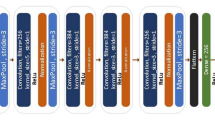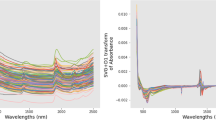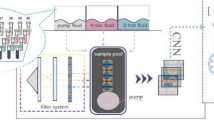Abstract
Given the facilitation of efficient soil data acquisition, light diffraction in both field and laboratory settings allows for applying infrared spectroscopy. This leads to the development of soil spectral library at regional and international levels owing to the extensive interest in the mid-infrared spectroscopy (MIR) domain. Spectroscopy practices meritoriously evaluate various soil constituents such as total nitrogen (TN), organic carbon (OC), potassium (K), and phosphorus (P) within the mid-infrared range, utilizing direct spectral responses and advanced modeling, mostly while analyzing fresh soil samples (undisturbed, wet). Machine and deep learning approaches potentially revolutionize soil spectral data modeling, demonstrating their transformative impact in various fields of study. A novel technique called DrSeq-ANN (dropout sequential artificial neural network), which falls under DL algorithms for predicting soil properties based on raw soil spectra, is proposed and evaluated in this investigation. The National Soil Survey Center-Kellogg Soil Survey Laboratory of the United States Department of Agriculture (USDA) database, comprising nearly 860 topsoil measurements from Kansas State having biological and physicochemical parameters, was employed. DrSeq-ANN outperformed other algorithms when fed to the pre-processed data with the help of techniques such as initial derivative, inverse derivative, logarithmic transformation with a base of 10 (Log10x), and logarithmic derivative. Specifically, while forecasting soil organic carbon, the DrSeq-ANN algorithm achieved R2 value of 0.79 and RMSE value of 0.03 with the logarithmic pre-processed method. With the competencies of the ANN model, DrSeq-ANN proved to be more accurate in prediction. The study confirmed that DrSeq-ANN can be trained in a multi-task setting to forecast the 4 soil factors (TN, OC, P, and K).














Similar content being viewed by others
Data Availability
The USDA National Soil Survey Centre-Kellogg Soil Survey Laboratory offers all data necessary to create prediction models on request.
References
Bellon-Maurel, V., & McBratney, A. (2011). Near-infrared (NIR) and mid-infrared (MIR) spectroscopic techniques for assessing the amount of carbon stock in soils - Critical review and research perspectives. Soil Biology and Biochemistry, 43(7), 1398–1410. https://doi.org/10.1016/j.soilbio.2011.02.019
Camargo, L. A., Marques, J., Barrón, V., Alleoni, L. R. F., Barbosa, R. S., & Pereira, G. T. (2015). Mapping of clay, iron oxide and adsorbed phosphate in oxisols using diffuse reflectance spectroscopy. Geoderma, 251–252, 124–132. https://doi.org/10.1016/j.geoderma.2015.03.027
Centner, V., Massart, D. L., De Noord, O. E., De Jong, S., Vandeginste, B. M., & Sterna, C. (1996). Elimination of uninformative variables for multivariate calibration. Analytical Chemistry, 68(21), 3851–3858. https://doi.org/10.1021/ac960321m
Dangal, S. R. S., Sanderman, J., Wills, S., & Ramirez-Lopez, L. (2019). Accurate and precise prediction of soil properties from a large mid-infrared spectral library. Soil Systems, 3, 11. https://doi.org/10.3390/soilsystems3010011
Du, C., & Zhou, J. (2011). Application of infrared photoacoustic spectroscopy in soil analysis. Applied Spectroscopy Reviews, 46(5), 405–422. https://doi.org/10.1080/05704928.2011.570837
Du, C., Goyne, K. W., Miles, R. J., & Zhou, J. (2014). A 1915–2011 microscale record of soil organic matter under wheat cultivation using FTIR-PAS depth-profiling. Agronomy for Sustainable Development, 34(4), 803–811. https://doi.org/10.1007/s13593-013-0201-6
Estienne, F., Massart, D. L., Zanier-Szydlowski, N., & Marteau, P. (2000). Multivariate calibration with Raman spectroscopic data: A case study. Analytica Chimica Acta, 424(2), 185–201. https://doi.org/10.1016/S0003-2670(00)01107-7
Jahn, B. R., Linker, R., Upadhyaya, S. K., Shaviv, A., Slaughter, D. C., & Shmulevich, I. (2006). Mid-infrared spectroscopic determination of soil nitrate content. Biosystems Engineering, 94(4), 505–515. https://doi.org/10.1016/j.biosystemseng.2006.05.011
Kimble, J., Reeves, J., Reeves, V., Follett, R., & McCarty, G. (2002). Mid-infrared and near-infrared diffuse reflectance spectroscopy for soil carbon measurement. Soil Science Society of America Journal, 66, 640–646. https://doi.org/10.2136/sssaj2002.6400
Knox, N. M., Grunwald, S., McDowell, M. L., Bruland, G. L., Myers, D. B., & Harris, W. G. (2015). Modelling soil carbon fractions with visible near-infrared (VNIR) and mid-infrared (MIR) spectroscopy. Geoderma, 239–240, 229–239. https://doi.org/10.1016/j.geoderma.2014.10.019
Leenen, M., Pätzold, S., Tóth, G., & Welp, G. (2022). A LUCAS-based mid-infrared soil spectral library: Its usefulness for soil survey and precision agriculture. Journal of Plant Nutrition and Soil Science. https://doi.org/10.1002/JPLN.202100031
Madari, B. E., Reeves, J. B., Machado, P. L. O. A., Guimarães, C. M., Torres, E., & McCarty, G. W. (2006). Mid- and near-infrared spectroscopic assessment of soil compositional parameters and structural indices in two Ferralsols. Geoderma, 136(1–2), 245–259. https://doi.org/10.1016/j.geoderma.2006.03.026
Michel, K., Terhoeven-Urselmans, T., Nitschke, R., Steffan, P., & Ludwig, B. (2009). Use of near- and mid-infrared spectroscopy to distinguish carbon and nitrogen originating from char and forest-floor material in soils. Journal of Plant Nutrition and Soil Science, 172(1), 63–70. https://doi.org/10.1002/jpln.200700246
Mohanraj, T., Yerchuru, J., Krishnan, H., Aravind, R. N., & Yameni, R. (2021). Development of tool condition monitoring system in end milling process using wavelet features and Hoelder’s exponent with machine learning algorithms. Measurement, 173, 108671.
Mouazen, A. M., Kuang, B., De Baerdemaeker, J., & Ramon, H. (2010). Comparison among principal component, partial least squares and back propagation neural network analyses for accuracy of measurement of selected soil properties with visible and near infrared spectroscopy. Geoderma, 158(1–2), 23–31. https://doi.org/10.1016/j.geoderma.2010.03.001
Natarajan, S., Thangamuthu, M., Gnanasekaran, S., & Rakkiyannan, J. (2023). Digital twin-driven tool condition monitoring for the milling process. Sensors, 23(12), 5431.
Pinheiro, É. F. M., Ceddia, M. B., Clingensmith, C. M., Grunwald, S., & Vasques, G. M. (2017). Prediction of soil physical and chemical properties by visible and near-infrared diffuse reflectance spectroscopy in the Central Amazon. Remote Sens., 9(4), 293. https://doi.org/10.3390/rs9040293
Rees, C. A., Provis, J. L., Lukey, G. C., & Van Deventer, J. S. J. (2007). Attenuated total reflectance fourier transform infrared analysis of fly ash geopolymer gel aging. Langmuir, 23(15), 8170–8179. https://doi.org/10.1021/la700713g
R. A. V. Rossel and V. I. Adamchuk (n.d) “Proximal soil sensing environment) view project application of variable-rate irrigation technology to conserve water and improve crop productivity view project 6 proximal soil sensing,” https://doi.org/10.13140/2.1.2799.1847.
Rossel, R. A. V., & Behrens, T. (2010). Using data mining to model and interpret soil diffuse reflectance spectra. Geoderma, 158(1–2), 46–54. https://doi.org/10.1016/j.geoderma.2009.12.025
Sarathjith, M. C., Das, B. S., Wani, S. P., & Sahrawat, K. L. (2016). Variable indicators for optimum wavelength selection in diffuse reflectance spectroscopy of soils. Geoderma, 267, 1–9. https://doi.org/10.1016/j.geoderma.2015.12.031
Schiedung, M., Bellè, S.-L., Malhotra, A., & Abiven, S. (2022). Organic carbon stocks, quality and prediction in permafrost-affected forest soils in North Canada. CATENA, 213, 106194. https://doi.org/10.1016/J.CATENA.2022.106194.Jun.2022
Shankar, S., Mohanraj, T., & Pramanik, A. (2019a). Tool condition monitoring while using vegetable based cutting fluids during milling of inconel 625. Journal of Advanced Manufacturing Systems, 18(04), 563–581.
Shankar, S., Mohanraj, T., & Rajasekar, R. (2019b). Prediction of cutting tool wear during milling process using artificial intelligence techniques. International Journal of Computer Integrated Manufacturing, 32(2), 174–182.
Terra, F. S., Demattê, J. A. M., & ViscarraRossel, R. A. (2015). Spectral libraries for quantitative analyses of tropical Brazilian soils: Comparing vis-NIR and mid-IR reflectance data. Geoderma, 255–256, 81–93. https://doi.org/10.1016/j.geoderma.2015.04.017
Vasques, G. M., Grunwald, S., & Sickman, J. O. (2008). Comparison of multivariate methods for inferential modeling of soil carbon using visible/near-infrared spectra. Geoderma, 146(1–2), 14–25. https://doi.org/10.1016/j.geoderma.2008.04.007
ViscarraRossel, R. A., & Lark, R. M. (2009). Improved analysis and modelling of soil diffuse reflectance spectra using wavelets. European Journal of Soil Science, 60(3), 453–464. https://doi.org/10.1111/j.1365-2389.2009.01121.x
ViscarraRossel, R. A., Walvoort, D. J. J., McBratney, A. B., Janik, L. J., & Skjemstad, J. O. (2006). Visible, near infrared, mid infrared or combined diffuse reflectance spectroscopy for simultaneous assessment of various soil properties. Geoderma, 131(1–2), 59–75. https://doi.org/10.1016/j.geoderma.2005.03.007
Vohland, M., & Emmerling, C. (2011). Determination of total soil organic C and hot water-extractable C from VIS-NIR soil reflectance with partial least squares regression and spectral feature selection techniques. European Journal of Soil Science, 62(4), 598–606. https://doi.org/10.1111/j.1365-2389.2011.01369.x
Xiaobo, Z., Jiewen, Z., Povey, M. J. W., Holmes, M., and Hanpin, M., (2010) Variables selection methods in near-infrared spectroscopy,” Analytica Chimica Acta, vol. 667, no. 1–2. Elsevier, pp. 14–32, https://doi.org/10.1016/j.aca.2010.03.048.
Yoshida, H., Leardi, R., Funatsu, K., & Varmuza, K. (2001). Feature selection by genetic algorithms for mass spectral classifiers. Analytica Chimica Acta, 446(1–2), 483–492. https://doi.org/10.1016/s0003-2670(01)00910-2
Acknowledgements
We appreciate the technical assistance provided by Richard Ferguson and Scarlett Bailey at the USDA NRCS National Soil Survey Centre in accessing the spectral library.
Funding
This research is supported through Phase-II of the Visvesvaraya PhD Scheme for Electronics and IT, MeitY (Ministry of Electronics and IT), Government of India (Unique Awardee Number: MEITY-PHD-3080).
Author information
Authors and Affiliations
Corresponding author
Ethics declarations
Disclaimer
Financial contributors do not play any part in data analysis and collection, study design, manuscript preparation, or decision in publishing contents.
Conflict of Interest
The authors declare no competing interests.
Additional information
Publisher's Note
Springer Nature remains neutral with regard to jurisdictional claims in published maps and institutional affiliations.
Rights and permissions
Springer Nature or its licensor (e.g. a society or other partner) holds exclusive rights to this article under a publishing agreement with the author(s) or other rightsholder(s); author self-archiving of the accepted manuscript version of this article is solely governed by the terms of such publishing agreement and applicable law.
About this article
Cite this article
Jakkan, D.A., Ghare, P. & Sakode, C. Multi-parameter Soil Property Prediction Incorporating Mid-infrared Spectroscopy and Dropout Sequential Artificial Neural Network. Water Air Soil Pollut 234, 694 (2023). https://doi.org/10.1007/s11270-023-06726-6
Received:
Accepted:
Published:
DOI: https://doi.org/10.1007/s11270-023-06726-6




